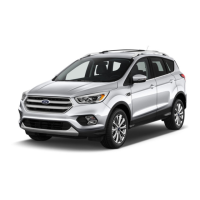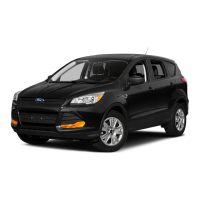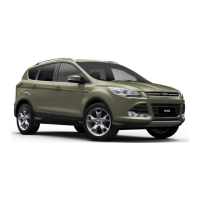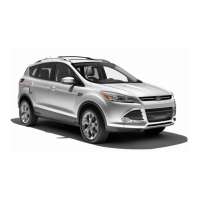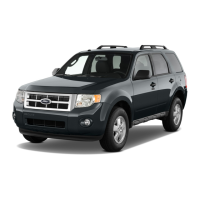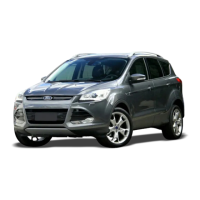
Do you have a question about the Ford ESCAPE 2014 and is the answer not in the manual?
| seating capacity | 5 |
|---|---|
| passenger volume | 98.1 cu. ft. |
| cargo volume behind 1st row | 67.8 cu. ft. |
| cargo volume behind 2nd row | 34.3 cu. ft. |
| total interior volume | 132.4 cu. ft. |
| fuel tank capacity | 15.1 gal. |
|---|---|
| fuel economy 2.5L FWD | 22 city/31 hwy mpg |
| fuel economy 1.6L FWD | 23 city/33 hwy mpg |
| fuel economy 1.6L 4WD | 22 city/30 hwy mpg |
| fuel economy 2.0L FWD | 22 city/30 hwy mpg |
| fuel economy 2.0L 4WD | 21 city/28 hwy mpg |
| engine type 1.6L | EcoBoost I-4 |
|---|---|
| engine type 2.0L | EcoBoost I-4 |
| engine type 2.5L | i-VCT I-4 |
| displacement 1.6L | 1.6 liters |
| displacement 2.0L | 2.0 liters |
| displacement 2.5L | 2.5 liters |
| horsepower 1.6L | 178 @ 5700 rpm |
| horsepower 2.0L | 240 @ 5500 rpm |
| horsepower 2.5L | 168 @ 6000 rpm |
| torque 1.6L | 184 lb.-ft. @ 2500 rpm |
| torque 2.0L | 270 lb.-ft. @ 3000 rpm |
| torque 2.5L | 170 lb.-ft. @ 4500 rpm |
| compression ratio 1.6L | 10.0:1 |
| compression ratio 2.0L | 9.3:1 |
| compression ratio 2.5L | 9.7:1 |
| bore and stroke 1.6L | 3.11 x 3.20 |
| bore and stroke 2.0L | 3.44 x 3.27 |
| bore and stroke 2.5L | 3.50 x 3.94 |
| towing class 2.5L | Light Duty Class I |
|---|---|
| towing class 1.6L EcoBoost | Light Duty Class I |
| towing class 2.0L EcoBoost | Light Duty Class I |
| towing class 2.0L EcoBoost with Trailer Tow Package | Medium Duty Class II |
| gross trailer weight 2.5L | 1500 lbs. max. |
| gross trailer weight 1.6L EcoBoost | 2000 lbs. max. |
| gross trailer weight 2.0L EcoBoost | 2000 lbs. max. |
| gross trailer weight 2.0L EcoBoost with Trailer Tow Package | 3500 lbs. max. |
| maximum tongue load 2.5L | 150 lbs. |
| maximum tongue load 1.6L EcoBoost | 200 lbs. |
| maximum tongue load 2.0L EcoBoost | 200 lbs. |
| maximum tongue load 2.0L EcoBoost with Trailer Tow Package | 350 lbs. |
| wheelbase | 105.9 inches |
|---|---|
| length | 178.1 inches |
| height | 66.3 inches |
| width with mirrors | 81.8 inches |
| width without mirrors | 72.4 inches |
| track front | 61.5 inches |
| track rear | 61.6 inches |
| ground clearance | 7.9 inches |
| base curb weight 1.6L FWD | 3502 lbs |
|---|---|
| base curb weight 1.6L 4WD | 3645 lbs |
| base curb weight 2.0L FWD | 3592 lbs |
| base curb weight 2.0L 4WD | 3732 lbs |
| base curb weight 2.5L FWD | 3515 lbs |
Guidance on how to use the owner's manual and information about features and illustrations.
Explanation of common symbols used in the manual and on the vehicle.
Recommendation for using genuine Ford and Motorcraft parts for maintenance and repair.
Safety warnings and considerations for using mobile communication devices while driving.
Diagram identifying key exterior features of the vehicle.
Diagram identifying key interior features of the vehicle.
Diagram identifying key components of the instrument panel.
General warnings and safety information regarding the use of child restraints.
Criteria for selecting an appropriate and properly fitted child restraint system.
Instructions and warnings for correctly installing child restraint systems.
Details on the location and use of top tether anchorages for child restraints.
Guidance on using booster seats and seatbelts for older children.
How to check if a seatbelt fits correctly for a child.
Information on operating child safety locks for rear doors.
Explanation of how seatbelts work and mandatory requirements for wearing them.
Instructions on how to properly fasten seatbelts and store them when not in use.
Procedure for adjusting the seatbelt height for optimal positioning.
Explanation of the seatbelt reminder system and its indicators.
Guidelines for inspecting and maintaining seatbelt assemblies.
General information and warnings about airbags and restraint systems.
Information on the driver airbag's location, deployment, and safety precautions.
Details on the passenger airbag's deployment and safety precautions.
Information on side airbags, including warnings about seat covers and maintenance.
Description of side curtain airbags and their deployment.
Information on the driver knee airbag and its operation.
Factors affecting remote control range and potential interference.
Details on reprogramming the unlocking function and changing the remote control battery.
Step-by-step instructions for disassembling and reassembling the remote control.
Information on purchasing and programming replacement keys or remote controls.
How to lock and unlock doors using power locks and the remote control.
Location and operation of the power door lock controls.
Using the remote control for locking and unlocking doors.
Procedure for locking all doors and confirming closure with indicators.
Explanation of the double locking feature for enhanced security.
Operation and safety warnings for the power liftgate.
Manual key operation for locking and unlocking doors.
Safety warnings and operating instructions for the manual liftgate.
Methods for opening the liftgate manually or with the remote control.
Procedure for closing the liftgate.
Instructions for programming the liftgate's opening position.
Information on using the hands-free feature to open/close the liftgate.
General information and warnings about the keyless entry system.
How the passive key works for locking and unlocking the vehicle.
Procedure for locking the vehicle using the passive key.
Notes regarding the operation of the luggage compartment lid.
How the vehicle unlocks using the passive key.
Instructions for using the physical key blade to lock and unlock doors.
Principle of operation and details about coded keys for the anti-theft system.
Information on how the anti-theft alarm works, including arming and disarming.
Instructions for adjusting the steering wheel position.
Explanation of audio controls on the steering wheel.
How to activate and use voice control features.
Information on using the cruise control system.
How to navigate menus using the information display controls.
Operating instructions and notes for windshield wipers.
Adjusting the intermittent wipe interval and sensitivity.
Information on the automatic windshield wipers.
Operating instructions for windshield washers.
Instructions for operating the rear window wiper and washer.
Information on condensation in exterior lamps.
Operation of the lighting control dial.
How to switch high beams on and off.
How to use the headlamp flasher.
Operation of the automatic headlamp system.
Adjusting the brightness of the instrument panel lighting.
How the headlamp exit delay feature works.
Information and warnings about daytime running lamps.
Operation and limitations of the automatic high beam control system.
How to operate the front fog lamps.
Operating the rear fog lamps with warnings.
Adjusting headlamp beams based on vehicle load.
How cornering lamps illuminate the inside of a corner when turning.
Operation and safety warnings for power windows.
Procedure for using the one-touch up feature for power windows.
How to lock and unlock the rear window controls.
How the bounce-back feature stops windows closing on obstacles.
How to override the bounce-back feature for windows.
Operating power windows globally with ignition off.
Procedure to open all windows and vent the moonroof remotely.
Procedure to close all windows and the moonroof remotely.
General information and warnings for exterior mirrors.
How to manually fold and unfold exterior mirrors.
How mirrors fold and unfold automatically.
Information and warnings about integrated blind spot mirrors.
Adjusting the interior mirror and its auto-dimming feature.
How to use sun visors for shade.
Safety warnings regarding moonroof operation.
Identification and function of instrument cluster gauges.
Description of information displayed in the instrument cluster.
General explanation of warning lamps and indicators.
Meaning and action for the ABS warning lamp.
Indicator for the automatic high beam feature.
Meaning and action for the battery warning lamp.
Meaning and action for the brake system warning lamp.
Function and troubleshooting for direction indicators.
Meaning and action for the engine oil warning lamp.
Explanation of malfunction and powertrain warning lamps.
Function of the seatbelt reminder warning lamp.
Indicator for front fog lamp operation.
Indication for outside air temperature below 4°C.
Indicator for diesel engine preheating.
Indicator for high beam operation and flasher use.
Indicator for new messages in the information display.
Indicator for Lane Keeping System status.
Indicator to refuel the vehicle.
Indicator for headlamp and parking lamp operation.
Indicator for rear fog lamp operation.
Indicator for optimal gear shifting for fuel economy.
Indicator when stability control is switched off.
Indicator for stability control system active or malfunction.
Indicator for auto start-stop system operation.
Description of audible warnings and indicators.
Using information display controls for vehicle systems.
How to use steering wheel controls to navigate the information display.
Overview of the information display menu structure.
Information on trip odometer, speed, fuel, and average speed.
Display of information related to seatbelts, driver alert, traffic signs, and AWD.
Driver assist, lighting, display, chimes, and convenience settings.
How the system displays active warnings and checks vehicle status.
Messages and actions related to phone functions.
Messages and actions for the Active City Stop system.
Messages and actions for the automatic high beam control.
Messages and actions related to battery and charging system faults.
Messages and actions for blind spot and cross traffic alert systems.
Messages and actions for child power lock faults.
Messages and actions for climate control functions.
Messages and actions for cruise control and adaptive cruise control.
Messages and actions for driver fatigue warning.
Messages indicating if doors are not completely closed.
Messages and actions for engine temperature and faults.
Messages and actions for hill start assist availability.
Messages related to keyless entry system operation.
Messages and actions for lane keeping system faults.
Messages and actions for lighting system faults.
Messages and actions related to vehicle maintenance.
Messages and actions for parking aid system faults.
Messages and actions related to the parking brake system.
Messages and actions for power steering system issues.
Message for auto start-stop switch operation.
Messages and actions for starting system issues.
Messages and actions related to towing.
Messages related to traction control system status.
Messages for transmission and 4WD system status.
Explanation of outside air and recirculated air functions.
Information on how heating performance depends on coolant temperature.
Tips for controlling interior climate, including closing windows.
How to direct air for warming the interior.
How to direct air for cooling the interior.
Explanation of air conditioning system directing condensation.
Diagrams showing the location of air vents.
Operation of the automatic climate control system.
Setting the temperature between 15°C and 30°C.
How temperature settings for driver and passenger sides are linked.
Procedure to switch off mono mode for independent temperature control.
General hints for controlling the interior climate.
Tips for manual climate control, including defogging.
Notes on automatic climate control operation and settings.
Operation and notes for heated windows and mirrors.
How to clear the windshield of ice and fog.
How to clear the rear window of ice and fog.
Notes regarding heated exterior mirrors.
Location and importance of the cabin air filter.
Safety warnings and guidelines for proper seating posture.
Warnings and instructions for adjusting head restraints.
Diagram and description of the front seat head restraint.
Description of the components of rear head restraints.
Procedure for adjusting, lowering, and removing head restraints.
Warnings and instructions for adjusting manual seats.
Procedure for moving the seat backward and forward.
How to adjust the lumbar support for comfort.
Warnings and instructions for adjusting power seats.
Diagrams illustrating the 10-way adjustment of power seats.
Operation of the power lumbar support feature.
Instructions for folding and unfolding rear seatbacks.
Procedure and warnings for folding the seatback.
Procedure and warnings for unfolding the seatback.
Warnings and instructions for using heated seats.
How to fold down the rear seat armrest and cupholder.
Warnings and notes for using the 12V DC power point.
Possible locations of power points in the vehicle.
Warnings and notes for the 230V AC power point.
Notes and warnings regarding the use of cup holders.
How to open the overhead console compartment.
Warnings for using folding trays while driving.
Warnings and notes about engine starting and operation.
How to switch the ignition on and off.
Procedure for starting the engine.
Operation and warnings for keyless starting.
How to switch the ignition to accessory mode.
Procedures for starting the vehicle with manual or automatic transmission.
Notes on starting a diesel engine.
Conditions that prevent the system from functioning.
How the fast restart feature allows quick engine restarts.
Warning about checking steering wheel lock before moving.
Notes on steering wheel lock engagement for keyless starting.
Procedure for unlocking the steering wheel.
Notes on operating the starter for gasoline engines.
Procedures for starting a cold or hot engine.
Procedure for starting the engine when flooded.
How engine idle speed is optimized after starting.
Procedures for starting a vehicle when it fails to start.
Function of the diesel particulate filter.
Information and warnings about the auto start-stop system.
How to use the auto start-stop system and its operational conditions.
Procedure for stopping the engine.
Procedure for restarting the engine.
General warnings and guidelines for handling automotive fuel.
Guidelines for diesel fuel quality, long-term storage, and winter driving.
Guidelines for gasoline fuel quality and octane recommendations.
Procedure and notes for when the vehicle runs out of fuel.
Warnings and instructions for refilling using a portable fuel container.
Warnings regarding catalytic converter operation.
Warnings and instructions for refueling the vehicle.
Instructions for selecting reverse gear in manual transmission.
Warnings and characteristics of automatic transmissions.
Description of selector lever positions (P, R, N, D, S).
Warnings and instructions for shifting into park.
Warnings and instructions for shifting into reverse.
Description of neutral gear position.
Description of drive gear position for optimal performance.
How to switch on sport mode.
Operation of SelectShift automatic transmission for manual gear changes.
Procedure to release the gearshift lever from park (P).
How the adaptive learning feature improves transmission operation.
How the four-wheel drive system anticipates and transfers torque.
Information on system warnings and default to front-wheel drive.
Operating characteristics in sand, mud, snow, and rough roads.
Principles for driving in crosswinds and slippery conditions.
Procedure if the vehicle leaves the road.
Guidelines for unavoidable emergency maneuvers.
Driving tips for sandy conditions, including overheating warnings.
Tips for driving on hills and slopes, including gear selection.
Cautions and advice for driving on snow and ice surfaces.
Methods for freeing a stuck vehicle.
Recommendations regarding vehicle maintenance and modifications.
General warnings and notes about brake system operation.
Procedure if the accelerator pedal becomes stuck.
How brake assist provides maximum braking efficiency.
How ABS helps maintain steering control during emergency stops.
Notes and risks associated with driving with ABS.
Instructions for applying and releasing the parking brake.
How traction control helps avoid wheel spin and loss of traction.
Automatic activation and disabling of traction control.
How to switch traction control off/on via the information display.
How to switch traction control off/on using the instrument panel switch.
Explanation of Electronic Stability Program (ESP) function.
How ESP supports stability by braking wheels and reducing engine torque.
Meaning of the stability control warning lamp.
Automatic activation and switching traction control off/on.
Limitations and warnings for the parking aid system.
Warnings and system limitations for parking aid.
Warnings about system design and potential false beeps.
Responsibilities and warnings for active park assist.
How the parking aid system detects obstacles and provides warnings.
Warnings and information about the rear view camera system.
Accessing rear view camera settings.
Selectable settings for enhanced park aids.
Selectable settings for rear camera delay.
How cruise control maintains set speed without foot on accelerator.
Warnings and notes for using cruise control.
Procedure to switch cruise control on.
Steps to set the desired cruise control speed.
How to adjust the set cruise control speed.
How to cancel the set cruise control speed.
How to resume the set cruise control speed.
Procedure to switch cruise control off.
Warnings and guidelines for using adaptive cruise control.
Procedure to switch adaptive cruise control on.
Steps to set the adaptive cruise control speed.
How the system adjusts speed to maintain a gap from the vehicle ahead.
How to decrease or increase the distance gap.
How pressing the accelerator overrides set speed and gap.
How to change the set speed and gap distance.
Notes on canceling the set speed.
Potential issues with radar sensor detection.
Conditions that cause the system to deactivate.
Information about blocked radar sensors.
How the brake support system alerts and reduces crash speed.
How to adjust the system's alert sensitivity.
How to switch from adaptive to normal cruise control.
Principle of operation and using the speed limiter system.
How to temporarily exceed the set speed limit.
Warnings for exceeding the set speed limit.
Principle of operation and warnings for the driver alert system.
How to use driver alert system, including on/off and system warnings.
Principle of operation for the lane keeping system.
Warnings and instructions for the lane keeping alert.
How to switch the lane keeping system on and off.
Adjusting the steering wheel vibration intensity.
Adjusting how quickly the lane keeping system warns the driver.
Warnings and system usage for blind spot detection.
How the blind spot information system operates.
Warnings and solutions for blocked sensors in the blind spot system.
What to do if the system senses a problem with the sensors.
How to temporarily switch the blind spot system off.
Principle of operation and warnings for Active City Stop.
How the ECO MODE system assists efficient driving.
Warnings and guidelines for securing loads and vehicle axle loads.
Information on luggage anchor points and retention nets.
Description of rear under floor storage and cargo management system.
How to adjust the load floor position.
Warnings and instructions for operating luggage covers.
Warnings and recommendations for using roof racks and load carriers.
Warnings and guidelines for towing a trailer.
Warning about anti-lock brake system and trailer brakes.
Warnings and information about trailer sway control.
Chart listing recommended towing weights by powertrain and transmission.
Guidelines for safe towing, including hitch and safety chain connections.
Warnings about connecting trailer brake systems and regulations.
Warnings about connecting trailer lamp wiring.
Practicing turning, stopping, and backing up with a trailer.
Guidelines for towing, including full-throttle starts and traffic conditions.
Instructions and warnings for launching or retrieving boats/PWCs.
Location and installation of towing eyes.
Warnings and procedures for towing the vehicle on four wheels.
Break-in procedures for tires, brakes, clutch, and engine.
Information on running in new tires.
Advice on avoiding heavy use of brakes and clutch during break-in.
Driving recommendations during the first 1,500 km.
Notes on potential ticking sounds in new diesel engines.
How cold temperatures affect system operation.
Warnings and instructions for driving through water.
Warnings and instructions for proper floor mat installation.
How to use hazard flashers for safety.
Location of the first aid kit.
Location of the warning triangle.
Warning about inspecting fuel leaks after a collision.
Warnings and instructions for jump starting the vehicle.
Procedure for connecting booster cables correctly.
Procedure for starting the engine after jump starting.
Locations of the pre-fuse box, engine, and passenger compartment fuse boxes.
Warnings and notes about the engine compartment fuse box.
Location of the passenger compartment fuse box.
Location of the luggage compartment fuse box.
Details of fuses in the engine compartment fuse box.
Warnings and instructions for changing a fuse.
Illustrations and identification of different fuse types.
General warnings, servicing recommendations, and daily checks.
Items to check daily: exterior lamps, interior lamps, warning lamps.
Checks to perform when refueling: washer fluid, tire pressures, tire condition.
Monthly checks: engine oil, coolant, brake fluid, leaks, horn, lug nuts.
Procedure for opening and closing the vehicle hood.
Diagram identifying components under the hood for 1.5L EcoBoost engine.
Diagram identifying components under the hood for 2.0L Duratorq-TDCi diesel engine.
Diagram identifying components under the hood for 2.0L EcoBoost engine.
Diagram showing the oil dipstick for the 1.5L EcoBoost engine.
Diagram showing the oil dipstick for the 2.0L Duratorq-TDCi diesel engine.
Diagram showing the oil dipstick for the 2.0L EcoBoost engine.
Procedure for checking the engine oil level.
Instructions and warnings for adding engine oil.
Warnings and instructions for checking engine coolant.
Warnings and instructions for checking brake fluid level.
Notes and recommendations for checking washer fluid.
Warnings and instructions for changing the 12V battery.
Procedure for removing and reinstalling the vehicle battery.
How to check the condition of wiper blades.
Procedure for changing wiper blades.
Procedure for removing the headlamp assembly.
Warnings for changing bulbs.
Instructions for removing and replacing headlamp bulbs.
Information on serviceable and non-serviceable bulbs.
Procedure for removing and replacing side repeater bulbs.
Instructions for changing bulbs in rear lamps.
Chart listing bulb functions and trade numbers.
Recommendations for washing and drying the vehicle exterior.
Warnings and checks before using an automatic car wash.
Warnings and instructions for cleaning headlamp lenses.
Instructions for cleaning chrome trim.
Recommendation to flush the vehicle underside frequently.
Guidance on cleaning plastic exterior parts.
Notes regarding interior cleaning products.
Notes on cleaning seatbelts.
Instructions for cleaning instrument cluster and screen displays.
Notes on cleaning the interior of rear windows.
Procedure for repairing minor paint damage.
Recommendations for cleaning wheel rims and covers.
Tire pressure data location and general notes.
Notes on front tires and non-directional tires.
Recommendation for tire rotation to ensure even wear.
Warnings and instructions for using snow chains.
How stability control affects driving characteristics.
Warnings and description of the tire pressure monitoring system.
How ambient temperature affects tire pressure.
Instructions for inflating tires when the warning lamp is on.
Notes on servicing tires and pressure sensors.
Procedure to re-learn tire pressure sensors after changing wheels.
How the TPMS detects and warns of low tire pressures.
Description and actions for TPMS warning lamps.
Steps to take if the TPMS warning lamp is on.
Overview of the TPMS reset procedure after tire changes.
Steps to carry out the TPMS system reset procedure.
Warnings and procedures for changing a road wheel.
Information on obtaining locking lug nut keys.
Guidelines for using a spare wheel.
Warnings and instructions for using the vehicle jack.
Identification of correct jacking and lifting points.
Location and information found on the vehicle identification plate.
Location of the vehicle identification number.
Meaning of the vehicle's built date.
Information on radio frequencies and reception factors.
Notes on CD compatibility and handling.
How MP3 and WMA tracks and folders are structured for playback.
Operation of the premium AM/FM/CD audio unit.
Overview of the SYNC 2 audio unit.
How to operate the audio unit controls.
How to select different audio modes (AM, FM, Line In).
Function of seek down and previous track buttons.
Function of seek up and next track buttons.
How to tune up the radio frequency band.
How to tune down the radio frequency band.
How to adjust sound settings like bass, treble, balance, fade.
General information about Digital Audio Broadcast (DAB) radio.
How radio ensembles group stations and display names.
How to select DAB1 or DAB2 bands and store presets.
Troubleshooting common audio unit display issues.
Overview of SYNC 2 features and capabilities.
Overview of phone functions and supported Bluetooth features.
Accessing and adjusting clock, display, sound, vehicle, and help settings.
Adjusting touchscreen display brightness, auto-dim, and wallpaper.
Adjusting sound settings like bass, midrange, treble, and EQ mode.
Settings for ambient lighting, camera, and valet mode.
Accessing settings for the vehicle's camera.
Procedure for enabling valet mode to lock the system.
Overview of navigation features: map preferences, route preferences, traffic preferences.
Settings for breadcrumbs, turn list format, and parking POI notification.
Options for setting preferred routes and avoiding specific road types.
How to choose areas to avoid when calculating routes.
How to set a destination, choose route options, and start navigation.
How to view map mode and adjust map appearance.
Accessing map display options via quick-touch buttons.
Procedure for storing the home address.
Procedure for adding a favorite destination.
Procedure for selecting a favorite destination for navigation.
How to adjust the navigation voice prompt level.
How the system searches for destinations with similar spellings.
Changing map display views (2D, 3D) and zoom settings.
Pairing cell phones and managing phone functions.
Procedures for making calls using voice commands or the touchscreen.
How to redial the last dialed number.
How incoming calls are indicated.
Sending and receiving text messages via the touchscreen.
Warnings and limitations for text messaging while driving.
Procedure for composing and sending text messages.
Accessing phone settings like Bluetooth and Do Not Disturb.
List of voice commands for phone functions.
How iPhone users can access Siri via voice button.
Warnings and requirements for the Emergency Assistance feature.
Notice regarding disclosure of vehicle and crash information.
Procedure to set Emergency Assistance and reminder.
Accessing information features like Traffic and Notific.
Accessing notification features.
Accessing climate control features via touchscreen.
Accessing system functions via unit buttons.
Procedure for loading navigation SD card and road safety warnings.
Warnings about driving while distracted.
Information on safe viewing of route instructions.
Procedure for setting a destination and starting guidance.
Accessing navigation menus via information display control.
How to enter destination details.
How to handle traffic problems along the route.
Saving and changing the home address.
Accessing a history of previous destinations.
Viewing a list of saved favorite destinations.
Searching for points of interest.
Setting up and storing new tours.
Saving current position as a favorite.
Setting route preferences like avoiding freeways or toll roads.
Customizing map display for journey.
Customizing display information and hazard warning feature.
Deleting personal data like home address.
Resetting navigation settings.
Procedure for storing the home address.
Procedure for adding a favorite destination.
Procedure for selecting a favorite destination for navigation.
How to adjust the navigation voice prompt level.
How the system searches for destinations with similar spellings.
Changing map display views (2D, 3D) and zoom settings.
How to view map mode and adjust map appearance.
Accessing map display options via quick-touch buttons.
How to scroll the map using arrow buttons.
Default screen and information display during route guidance.
How the hazard spot warning feature informs about traffic areas.
How to switch the hazard warning feature on or off.
Information on purchasing annual navigation map updates.
Information on SD Logo and software approvals.
Vehicle compliance with EMC legislation and equipment fitting warnings.
Ownership of software, media, and content.
Compliance with applicable international export laws.
Trademarks of Ford Motor Company and affiliates.
Information on obtaining product support for the software.
Limitations on liability for software use.
Details on speech recognition, reverse engineering, and distribution limitations.
License terms for using the software.
Conditions for permanently transferring software rights.
Conditions for terminating the End User License Agreement.
Information on WMDRM technology and software upgrades.
Agreement to the collection and use of technical data.
Components enabling internet-based services and automatic updates.
Availability of software updates and additional services.
Information about linking to third party sites and responsibilities.
User's obligation to drive responsibly and read instructions.
Conditions for installing upgrade or recovery software.
Information about Adobe technologies used in the system.
Important safety information for the Windows Automotive-based system.
Guidance on voice command control and screen viewing while driving.
Understanding speech recognition limitations and errors.
Instructions and safety information for navigation features.
Warnings about potential distraction from navigation features.
Importance of personal judgment over navigation suggestions.
Warnings against following unsafe or illegal route suggestions.
Information on potential map inaccuracies.
Do not rely on navigation features for emergency service locations.
Terms and conditions for using Telenav Software.
